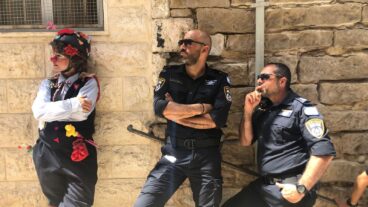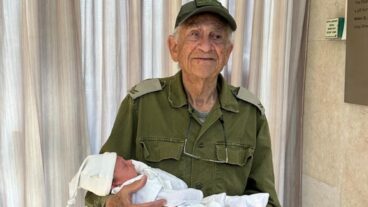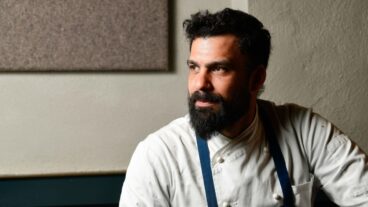Itay Gil, left, provides instruction to a security professional during one of Protect’s training courses.Itay Gil looks like the kind of guy you wouldn’t want to encounter in a dark alley – or even a fully lit one. With a bald pate and a body sculpted out of rock, the 44-year-old Israeli former anti-terror commando is exactly what you would expect an anti-terror commando to be like – intense, no-nonsense, and totally focused.
Gil’s focus these days is Protect – the company he founded in 1997 – it’s among few official private outsource solutions for Israel government agencies and the Israel Defense Forces. And since 9/11 Gil’s been offering his expertise to training forces around the world.
“Terrorism is a worldwide phenomenon, no matter where you look,” said Gil from behind his desk at the Protect headquarters in Jerusalem, which doubles as a gym and close battle quarter simulation facility. “If you go to Spain, if you go to the US, they all have shared experiences. And unfortunately, terrorism will be a large, and very big issue for the foreseeable future. And it touches law enforcement as well as the private security sector and areas like aviation, and maritime.”
So, what does Gil offer that sets him apart, one asks very politely?
“I bring to the table something very special: my knowledge is a combination of hand-to-hand combat and weapons tactics. Here,” he says, sweeping his arm across the facility where two students are in the midst of a robust kick boxing session, “we can do scenarios for police and law enforcement in controlling and restraining would-be terrorists, dealing with domestic violence or someone shooting in a school or a classroom. We have all the paintball guns and the weapons, so we can simulate the real deal.”
But where Gil really thrives and can impart wisdom to security officials is in the area of the psychology of terror and terrorists. After completing his compulsory army service, he was chosen to join Israel’s elite counter-terror and hostage rescue commando unit, ‘Yamam’, where he became a career combatant. During the course of 10 volatile years, he participated in as many as three missions each day.
“If you say Yamam around the world to a member of a SWAT or tactical team… most of them will know what you’re talking about. Every year there are hundreds of people that try to apply for the unit and a very small amount, maybe less than 1% are accepted,” said Gil. “I was with them six years as a combat fighter, and another five years I was chief trainer for all the special and tactical forces for the border police and special units undercover agencies.”
What he learned – and taught – during his years there, were tactics to prevent successful terror attacks, from combat skills to the element of surprise, ultimately how to save lives.
“We’re not just talking about punching, kicking, blocking, shooting, we are also talking about safety. I believe if a police officer takes one of our courses, we are teaching him how to minimize the damage, which is number one. And the other thing is operational behavior; how to approach the scene. You can come up to a criminal and talk to him at a very close range and suddenly find yourself stabbed and trying to protect yourself from a knife. Now if you did that from three or four yards away and used authority and body language, the result would be different,” said Gil.
Following his years with Yamam, Gil directed all the training programs for the Israel Border Police as well as the undercover police intelligence unit from 1992 to 1997, building programs for over 5,000 policemen and security personnel each year. And the primary lesson he taught was the need to evaluate each situation as it arises.
“That’s why we do so many different scenario trainings,” he said. “And people can come up to me and say, “I want to try this, I want to try that.” Let put it to a test. And of course, we’ll videotape the training sessions so later on we can play it on a screen and people can see how they did in their duties. A lot of people don’t perform very well. It’s not to criticize them. It’s to teach them to make it better when it comes to real life.”
With the reputation he had garnered in Israel, it was only a matter of time until security organizations abroad began to knock on Gil’s door. He’s consulted with police and security officials throughout Europe, and has conducted classes for American FBI and Swat teams. Next month, he’ll be going back to the US to lead instruction in VIP protection for a private security firm.
“In general, these people are very thirsty to learn about Israeli operational experience. Many American units consult with the Israeli government agencies and there’s a lot of cooperation against combating terrorism globally. We are all united in the same goal: to make a safer world and to live in peace. Americans traditionally have had a different attitude regarding terror, but 9/11 shocked everyone. There’s now a large budget out there, and but I’m not so sure they’re doing the right thing with the money,” he said.
“In my opinion, the first line of defense is the civilian. We also provide seminars for civilians, for survival skills. Let’s say there is a shooting at a high school. It doesn’t mean the guy is al-Qaeda. But he’s a psychopath creating a scenario that is very close and related to terrorism. So if you have a crazy guy coming into a university shooting 20-30 people, the response has historically been bad.
“But there’s a great way to minimize damage. And the first way would be to prepare the students – kids that already have some athletic abilities. ‘Take Charge’ would be the name of the course, to take charge of their own lives. If you would wait until a policeman would arrive in your classroom to “put position in hold,” it’s already too late.”
Among the exercises Gal runs through with clients is bursting into a classroom and shooting a round from a paintball gun. According to Gil, if the students, instead of cowering under their desks or attempting to flee, collectively engaged in combat, closed the distance, threw chairs at the attacker and shielded their upper bodies with briefcases or books, it would likely prevent a bigger massacre from occurring.
“West Virginia was a classic. It took a 70-year-old Holocaust survivor to fight back and block the door, with his own body, and he died in the process. The thing is – doing nothing you are going to die anyhow. If you will not take action, you will not survive. At least dying in the process means you tried,” says Gil.
That’s the lesson behind Gil’s 2004 book, Stopping Suicide Attackers, a primer that encapsulates Gil’s methods for the layman.
“The book gave us serious exposure and helped put Protect on the map globally today. Everyone who does serious research into who is going to do security training for him will see Protect on the Internet,” Gil said.
One of the lessons in the book relates to the concept of engagement at the time of attack, a type of response Gil says is native to Israelis.
“Over here in Israel we have this environment that if I were to see a civilian being attacked by someone or if I were to see a terrorist activity happening in the street, there would be a lot of engagement. If it was a terrorist, bystanders would probably gun him down, that being legally justified. If it were a criminal mugging an old lady, someone would control and restrain him until police would come. Israelis, if they would see a policeman in trouble, would immediately stop their car, get out and assist him. There is no such thing to pass by here.”
Gil, who has five children, tries to spend whatever free time he has with them. And among his hobbies are – guess what – contact sports and various kinds of fighting. But he also has a passion for cooking.
“I love being a chef. I’m very good with the knives in my kitchen,” he says, cracking a rare smile.
His oldest son, aged 16, is a computer buff, and Gil predicts that when he does his compulsory army service at 18, he’ll do something related to high tech in the army, a thought that sits well with the senior Gil.
“I don’t think he’ll follow my footsteps as a combat person, he’s not into that stuff and that’s okay,” he said.
But Gil remains into ‘that stuff’, with the same passion he had as an 18-year-old. And whether it’s in a dark or light alley, or in a close battle quarter simulation, that’s a comforting thought.![]()











